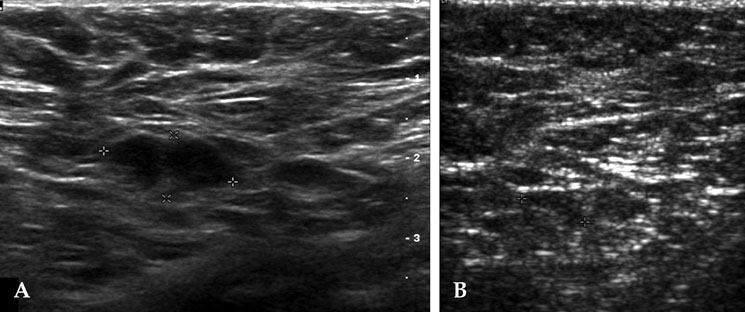Yonsei Med J.
2008 Apr;49(2):249-254. 10.3349/ymj.2008.49.2.249.
The Safety and Efficiency of the Ultrasound-guided Large Needle Core Biopsy of Axilla Lymph Nodes
- Affiliations
-
- 1Department of Diagnostic Radiology, The Research Institute of Radiological Science, Yonsei University College of Medicine, Seoul, Korea. ejsonrd@yuhs.ac
- 2Department of Diagnostic Radiology, Pochon CHA University, College of Medicine, Seoul, Korea.
- 3Department of Diagnostic Pathology, Pochon CHA University, College of Medicine, Seoul, Korea.
- KMID: 1084498
- DOI: http://doi.org/10.3349/ymj.2008.49.2.249
Abstract
- PURPOSE
To evaluate the safety and efficiency of the Ultrasound (US)-guided large needle core biopsy of axilla lymph nodes. MATERIALS AND METHODS: From March 2004 to September 2005, 31 patients underwent the US-guided core biopsy for axilla lymph nodes. Twenty five lesions out of 31 were detected during breast US, and 6 of 31 cases were palpable. Lymph nodes were classified based on their shape and cortical morphology. The core biopsy of axilla lymph nodes was performed on suspicious lymph nodes found during breast ultrasonography to find out whether the patients had a history of breast cancer or not. Among the 31 patients, 16 patients were associated with breast cancer. The lesion sizes varied from 0.6cm to 3.3cm (mean = 1.59 +/- 0.76cm). US-guided core biopsies were performed with 14G needles with an automated biopsy gun. Total 3 or 5 specimens were obtained. RESULTS: Among the 31 cases of axilla lymph nodes core biopsies, 11 cases showed malignant pathology. Seven out of 11 cases were metastatic lymph nodes from breast cancer; 2 cases were from primary unknown and 2 cases from lymphomas. On the other hand, 20 histopathologic results of axilla lesions were benign: subacute necrotizing lymphadenitis (n=2), dermatopathic lymphadenitis (n=1), reactive hyperplasia (n=10) and free of carcinoma (n=7). CONCLUSION: The US-guided large needle core biopsy of axilla lesions is safe and effective for the pathological evaluation. The core biopsy is believed to be easy to perform if suspicious lymph nodes or mass lesions are found in the axilla.
Keyword
MeSH Terms
Figure
Reference
-
1. Lernevall A. Imaging of axillary lymph nodes. Acta Oncol. 2000. 39:277–281.
Article2. de Kanter AY, van Eijck CH, van Geel AN, Kruijt RH, Henzen SC, Paul MA, et al. Multicentre study of ultrasonographically guided axillary node biopsy in patients with breast cancer. Br J Surg. 1999. 86:1459–1462.
Article3. Krishnamurthy S, Sneige N, Bedi DG, Edieken BS, Fornage BD, Kuerer HM, et al. Role of ultrasound-guided fine-needle aspiration of indeterminate and suspicious axillary lymph nodes in the initial staging of breast carcinoma. Cancer. 2002. 95:982–988.
Article4. Oruwari JU, Chung MA, Koelliker S, Steinhoff MM, Cady B. Axillary staging using ultrasound-guided fine needle aspiration biopsy in locally advanced breast cancer. Am J Surg. 2002. 184:307–309.
Article5. Jaffer S, Zakowski M. Fine-needle aspiration biopsy of axillary lymph nodes. Diagn Cytopathol. 2002. 26:69–74.
Article6. Damera A, Evans AJ, Cornford EJ, Wilson AR, Burrell HC, James JJ, et al. Diagnosis of axillary nodal metastases by ultrasound-guided core biopsy in primary operable breast cancer. Br J Cancer. 2003. 89:1310–1313.
Article7. Abdsaleh S, Azavedo E, Lindgren PG. Ultrasound-guided large needle core biopsy of axilla. Acta Radiol. 2004. 45:193–196.
Article8. Liberman L. Clinical management issues in percutaneous core breast biopsy. Radiol Clin North Am. 2000. 38:791–807.
Article9. Liberman L. Percutaneous image-guided core breast biopsy. Radiol Clin North Am. 2002. 40:483–500. vi
Article10. Hsu C, Leung BS, Lau SK, Sham JS, Choy D, Engzell U. Efficacy of fine-needle aspiration and sampling of lymph nodes in 1,484 Chinese patients. Diagn Cytopathol. 1990. 6:154–159.
Article11. Susini T, Nori J, Vanzi E, Livi L, Pecchioni S, Bazzocchi N, et al. Axillary ultrasound scanning in the follow-up of breast cancer patients undergoing sentinel node biopsy. Breast. 2007. 16:190–196.
Article12. Nori J, Bazzocchi M, Boeri C, Vanzi E, Nori Bufalini F, Mangialavori G, et al. Role of axillary lymph node ultrasound and large core biopsy in the preoperative assessment of patients selected for sentinel node biopsy. Radiol Med (Torino). 2005. 109:330–344.
- Full Text Links
- Actions
-
Cited
- CITED
-
- Close
- Share
- Similar articles
-
- Imaging Findings of Palpable Benign Masses in the Axilla
- The Usefulness of Ultrasound-Guided Fine Needle Aspiration in Breast Lesions
- Pseudoaneurysm of the Breast after Core Needle Biopsy: A Case Report
- The Efficacy of an Ultrasound-guided Core Needle Biopsy with an 18G Cutting Needle for the Diagnosis of Pancreatic Diseases
- Breast Lesions with Discordant Results on Ultrasound-guided Core Needle Biopsy




